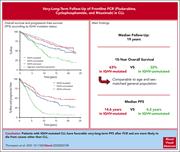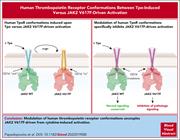Issue Archive
Table of Contents
BLOOD COMMENTARIES
HOW I TREAT
How I treat secondary CNS involvement by aggressive lymphomas
Lymphoma that spreads to the central nervous system concurrent with systemic disease (secondary central nervous system [CNS] lymphoma) is a challenging clinical problem with no established standards for treatment. Alderuccio and coauthors used 5 illustrative cases to discuss their approach and recommendations regarding chemoimmunotherapy, autologous stem cell transplantation, and chimeric antigen receptor T-cell therapies.
CLINICAL TRIALS AND OBSERVATIONS
Sustained remissions in CLL after frontline FCR treatment with very-long-term follow-up
Clinical Trials & Observations
Brief Report
Thompson et al report on the very-long-term follow-up of frontline treatment of chronic lymphocytic leukemia (CLL) with fludarabine, cyclophosphamide, and rituximab (FCR). For patients with mutated IGHV gene (IGHV-M) CLL, at a median follow-up of 19 years, median progression-free survival (PFS) was 14.6 years, with relapses after 10 years being uncommon. With unmutated IGHV, median PFS was only 4.2 years. Unfortunately, 32% of patients developed a secondary malignancy, with 6.3% being fatal myeloid neoplasms. For IGHV-M CLL, FCR provides a functional cure for a significant fraction of patients that must be balanced against the likelihood of secondary malignancy.
IMMUNOBIOLOGY AND IMMUNOTHERAPY
Reinforced antimyeloma therapy via dual-lymphoid activation mediated by a panel of antibodies armed with bridging-BiTE
Bispecific antibodies with T-cell engager (BiTE) are a promising therapy for multiple myeloma, but downregulation of the target antigen may lead to recurrence. Konishi and colleagues report on a novel bridging-BiTE (B-BiTE) that binds the immunoglobulin G Fc domain and CD3. When bound to commercially available monoclonal antibodies, B-BiTEs induce antitumor T-cell responses, preserve natural killer cell reactivity, and exhibit enhanced antimyeloma effects.
LYMPHOID NEOPLASIA
Genetic alterations and MRD refine risk assessment for KMT2A-rearranged B-cell precursor ALL in adults: a GRAALL study
KMT2A-rearranged (KMT2A-r) B-cell precursor acute lymphoblastic leukemia (BCP-ALL) is a high-risk leukemia. Kim and colleagues used molecular profiling and minimal residual disease (MRD) assessment to better stratify outcomes in adults with KMT2A-r BCP-ALL treated with intensive chemotherapy. The authors demonstrated considerable heterogeneity; while patients with TP53 or IKZF1 mutation had poor outcomes (overall survival 28%), those who lacked these mutations and were MRD-negative after therapy had a 3-year overall survival of 92.9%. These studies should guide risk-stratified therapeutic strategies including decisions regarding transplant in first remission.
MYELOID NEOPLASIA
Modulation of human thrombopoietin receptor conformations uncouples JAK2 V617F-driven activation from cytokine-induced stimulation
The thrombopoietin receptor (TpoR) plays a central role in the pathogenesis of all myeloproliferative neoplasms (MPNs), regardless of mutations in JAK2, calreticulin, or TpoR; but there has been minimal focus on inhibiting TpoR activation since they are likely to inhibit both physiologic and pathologic TpoR activity. Papadopoulos et al open a possible therapeutic strategy for targeting TpoR by demonstrating that the conformation of the receptor differs between Tpo vs JAK2 V617F-induced activation. The authors identified specific mutations that can disrupt mutant JAK2 activation, offering an entry point for new drug discovery to treat MPN.
TRANSPLANTATION
Spatial transcriptomics reveals distinct tissue niches linked with steroid responsiveness in acute gastrointestinal GVHD
Patel and colleagues used spatial transcriptomics to define the interaction of immune, colonic epithelial, and vascular endothelial cells with biopsies in patients with severe acute graft-versus-host-disease (aGVHD) of the colon. The authors demonstrated different gene signatures associated with steroid-responsive vs resistant disease. In addition, they identified localized expression of USP17L as a prognostic marker associated with decreased survival.
BLOOD WORK
ERRATA
RETRACTION
-
Cover Image
Cover Image
![issue cover]()
Sequential immunotherapy using 2 different clinically available antibodies armed with bridging-BiTE further augments antimyeloma effects via dual-lymphoid activation. The fluorescent image shows significant reduction of human CD138+ myeloma (red). See the article by Konishi et al on page 1789.
- PDF Icon Front MatterFront Matter
- PDF Icon Table of ContentsTable of Contents
- PDF Icon Editorial BoardEditorial Board
Advertisement intended for health care professionals
Email alerts
Advertisement intended for health care professionals









Functional cure reported in CLL
Clinical Trials & Observations